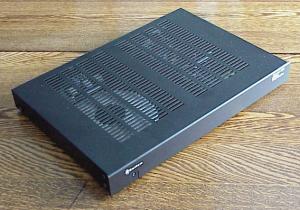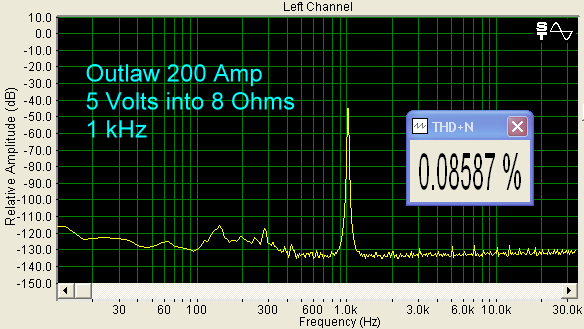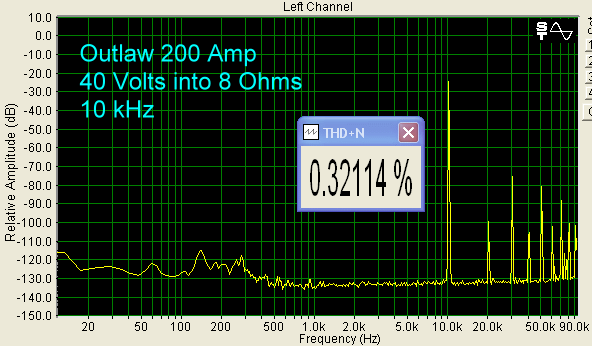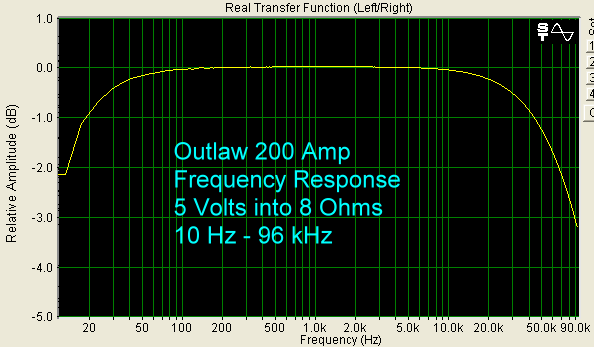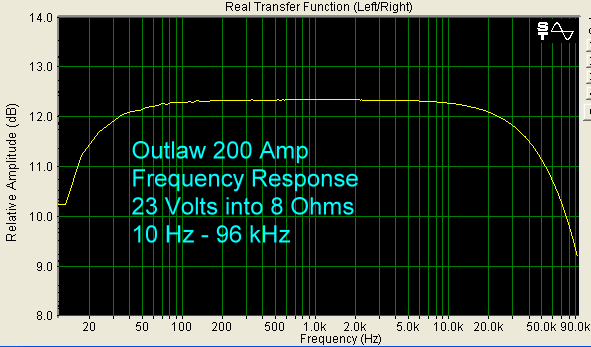|
||||||||||
|
Introduction Outlaw Audio represents a trend that someday will be the way most companies sell products. The people who run it sell amplifiers through regular channels (dealers), but they are other brands. Then, they sell the Outlaw products only on the Internet, at prices that save you some money compared to buying them from a showroom. The Outlaw products may compete a bit with their other brands not sold on the Internet, but the sales put money in the cash register either way, and offer a product line in a way that most companies don't have yet. We have reviewed several Outlaw products, and the model 200 monoblock is their newest one. It delivers 200 watts rms into 8 ohms and 300 watts into 4 ohms. As you can see from the photo at left, it is pretty simple in its appearance. All the money is in the circuitry. You can see the large flat toroidal transformer in the photo, which takes up a good percentage of the chassis space. One nice thing about monoblocks is that the power supply is dedicated to just that one channel, and it does not have to share power with anybody. In the case of the model 200, there are 20,000 microfarads of capacitance with ± 80 volts DC, for 128 Joules of energy storage. The rear panel of the 200 has a single unbalanced RCA input jack, 12 v trigger in/out jacks, a switch to select on, auto on with music, or auto on with the 12 v trigger. There is one set of five-way binding posts, voltage selector (USA or Europe), main power toggle, and a grounded AC socket for use with the included detachable power cord. Its low height allows for stacking several one on top of the other in a rack, rather than having to put them side by side, which would chew up a lot of space. It did not get very warm in use, so I suspect that only a watt or two are in Class A. The low heat factor also is good for stacking several 200s. If you have several 200s, all you need to do is connect the first one to the trigger on your processor, then run another trigger cable from the "12V Trigger Out" socket on the first unit to the "12V Trigger In" socket on the second unit. Do the same from the second unit to the third, and so on. You can also just set each unit to turn on with music input. Click on the photo above to see a larger version. The chassis itself is thin metal, so most of the 18 pound weight is the power supply and remaining circuitry. If you multiply this x 5 you have 90 pounds for a home theater amplifier. When it comes to amplifiers, heavy is good. The circuit uses 6 stages. Up to 80 watts, it is Class A/B, and above 80 watts, the amplifier switches (in 2 microseconds) to Class G (digital switching amplification). The combination of Class A/B and Class G in one amplifier is a little out of the ordinary. The Listening I tested the 200 with a Toshiba DVD player, Theta Digital Casablanca II Processor, Rotel RMB-1095 Power Amplifier on other channels (I had two 200s for the review), and a variety of speakers. Cables were Nordost and BetterCables. My Rotel 1095 is also rated at 200 watts rms into 8 ohms, but it is entirely Class A/B. The Outlaw seemed to hold its own in comparison. Plenty of dynamics (headroom) with action films, and still musical when the bombs stopped dropping. I was particularly impressed with how quiet the 200 was, and this is shown in the bench tests below. It has a very low noise floor. Maybe this is partly because it is the only amplifier in the chassis. No processor, no additional channels. Whatever. It worked for me. I am not going to sit here and write that the Outlaw 200 sounded as smooth as my Balanced Audio Technology VK-500 (250 watts per channel) or McIntosh MC-602 (600 watts per channel), each of which costs thousands of dollars, but it sounded just fine. It isn't meant to scare Mark Levinson or any other ultra-high end manufacturer. It is meant to deliver some rear end kicking dynamics for a home theater evening, yet sound clear and quiet for music, and still be affordable for anyone. This would be a great little amp to add to a mass market receiver pre-outs, on for example, just the center channel, where most of the energy is concentrated. In fact, I used a single Outlaw 200 to drive a pair of center channel speakers in parallel, producing a 4 ohm load, and it sounded great. I was using the system to watch some new DVDs of old movies that just came in, and which have mono sound into the center channel (no sound in any of the other channels).
OK, Outlaw Audio has convinced me. One other use for a nice inexpensive monoblock like this is for tactile transducers. I happened to have a Clark Synthesis Platinum TST429 here at the same time as the Outlaw 200. It responds 5 Hz to 800 Hz. It has a 4 ohm impedance, but does not require all that much power (100 watts or so), so something like the Outlaw 200, which is rated at 300 watts rms output into 4 ohms, will be quite suitable. The Outlaw 200 can be used to drive a Clark Synthesizer, but the ButtKicker requires more power, 400 watts to 1000 watts. By the way, the Clark and the ButtKicker are two entirely different products. The ButtKicker uses a heavy magnetic cylinder that will shake a platform due to its mass. It focuses on the really low frequencies. The Clark, by comparison, does not have as much mass in its chassis that moves, but it will respond to higher frequencies. (It will respond as low as the ButtKicker, but will not move the platform as much because of its lower mass.) It is made to give you a tactile sensation up through several hundred Hertz. Since explosions and other action sounds do include frequencies in the 200 Hz to 400 Hz range, for those who really want the complete experience, it might be advisable to have both the ButtKicker (for heavy shaking at 10 Hz - 40 Hz) and Clark Synthesizer (for shaking at higher frequencies) units mounted, perhaps the ButtKicker on the platform, and the Clark on one of the braces inside the chair or couch. (That would be an invalid way to test and compare the two products though, as each one would vibrate in sympathy with the other. If you want to compare them, only one should be mounted at a time.) On the Bench At 1 kHz, the Outlaw performed very respectably at 5 volts into 8 ohms (a few watts, typical listening level), and also at full output (40 volts into 8 ohms, which equals 200 watts).
These numbers are higher than the manufacturer specification, but still OK. At 10 kHz, the THD is good as well.
With multiple tones, 11 kHz and 12 kHz, THD is still low, and IMD is low too. So far, so good.
The distortion numbers stayed the same at full output no matter how long I left the test tones on. This means that it will sustain power output during those intense action scenes, without clipping (we define clipping as 1% THD or higher). The frequency response is the only area I see room for improvement. It starts rolling off about 3 kHz, although it is down only 0.3 db at 20 kHz. The low end though suffers a bit, dropping 1 dB at 20 Hz. Perhaps this is an overzealous use of an input capacitor (these are commonly used to prevent DC from getting into the power amplifier from the preamplifier). I would suggest using a higher value to keep it reasonably flat to 20 Hz. It is not so much that you can't boost the low end with a tone control somewhere, but there is phase shift where you have frequency response rolloff.
Conclusions The Outlaw 200 monoblock is a good value. I am not surprised at the test results, because Outlaw has a reputation for selling good stuff for minimum bucks. It could stand a little fiddling with here and there, but even so, the current version is well worth the $299 and should find a niche for those who need "just one or two more power amplifiers" to complete their home theater setup.
- John E. Johnson, Jr. -
|
||||||||||

